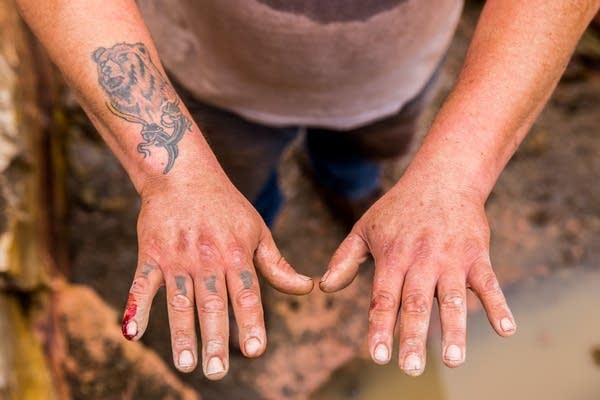Fulfilling a promise in stone: Pipestone National Monument

The last stop of our winding journey through the National Park sites in Minnesota brings us to the prairie grasslands of the southwest corner of the state, and Pipestone National Monument. In 1858, the Yankton Sioux signed a treaty with the U.S. government, creating the monument. The goal of the treaty was to slow the encroachment of white settlers while ensuring Indian access to the pipestone they considered sacred, found layered deep in the quartzite beneath the topsoil.

Named by Pres. Franklin D. Roosevelt as a National Monument in 1937, the area encompasses numerous quarries. Here, native people have long removed the soft red stone to craft pipes used in traditional ceremonies. The monument sits at the intersection of history and living Native American culture.
Cicadas and a crop duster battle for sonic supremacy as Travis Erickson, a fourth generation pipestone quarrier and pipe maker, bails water out of the quarry to begin the day's work.
Erickson, of both native Dakota and Norwegian heritage, is one of the few who earn a living from the quarrying and carving of pipestone. This is Erickson's second quarry. His first eventually reached 18 feet deep after 36 years of removing quartzite to get to the downward sloping pipestone.
Create a More Connected Minnesota
MPR News is your trusted resource for the news you need. With your support, MPR News brings accessible, courageous journalism and authentic conversation to everyone - free of paywalls and barriers. Your gift makes a difference.
"I'm either out in the garage carving or I'm out here quarrying." - Travis Erickson

Tattooed on his right forearm is a totem of his spirit guide, a bear, and on his right hand, bear claws. Over the years, he has had them re-inked as they faded from the rough work in all kinds of weather. For Erickson, these tattoos signify his strength and stubbornness.
"I resonate with Bear — you never see a herd of bears, they are always by themselves..." he said. "I like to be down here by myself and do all the quarrying and it's always been like that for me. This is my church here."
Down in the quarry where Erickson is working, you can see the layer of pipestone. It's a rich red, sandwiched between pinkish layers of quartzite. Quartzite is prized by many for its strength and good looks, but for quarriers like Erickson, it's an opponent to defeat.

Erickson must read the quartzite cracks and break them open to expose the sacred stone below. His process of breaking the stone is not much different than it was in centuries past, except steel wedges have replaced wooden ones. Once the quartzite is broken, it reveals a pipestone layer, which can be up to 18 inches thick. The thicker pipestone is highly desired, since it allows carving larger and more ornate pipes.
"...shall be secured in the free and unrestricted use of the red pipe-stone quarry... keep it open and free to the Indians to visit and procure stone for pipes so long as they shall desire. " - Yankton Sioux Treaty of 1858
Any member of a Native American band can now dig for pipestone at the monument, but it wasn't always that way. For 79 years after the signing of the treaty, native people had to fight to gain the access to the quarries guaranteed by the terms of the treaty, according to the Park Service. This period is marked by land disputes, court fights, forced relocations, and squatters. It wasn't until 1937 when the monument was established that Native Americans received guaranteed access.

Today, Pipestone National Monument is operated as a partnership between native people, through the Pipestone Indian Shrine Association, and the federal government through the National Park Service.
Glen Livermont, superintendent of the Pipestone National Monument, said "Pipestone is a living monument not only preserving objects of antiquity, but tasked with ensuring the living future in partnership with the native nations."
For the general public, there are carving demonstrations by Erickson and others, and a shop where visitors can buy carved pieces. Erickson has been quarrying at Pipestone for 43 years, and has been demonstrating his craft since 2000.

Among Native Americans, the quarrying is not without controversy. Some feel that selling the unworked rock to non-natives — or even selling worked pipestone — is contrary to the purpose of the sacred stone.
Erickson isn't bothered by the arguments. He makes a living from selling both raw pipestone and carved pipes to native and non-native people around the world.

"People want to carve their own pipes, so I don't believe that I should stop them from their dreams, too. I get a lot of non-Indian people who buy raw stone from me so they can carve their own pipes. I believe in equalness."
For Erickson, this is a way to preserve a tradition his mother taught him, but no one else in his family carves pipes.

"When I'm done, we're done," said Erickson.
Even so, he is passing on knowledge gained from 40 years in the quarry. A family from Hot Springs, South Dakota works the quartzite a few feet from Erickson. The group, made up of a father, two sons, and two nephews, come out for four days each year.
"I've helped them out four years in a row, and they've gained pretty good knowledge," Erickson said.
For Erickson, this has been a slow summer of quarrying. The heat and rain have made the work difficult. Still, he is hoping to get enough pipestone to last him through a winter of carving.
Erickson turned back to the stone wall to continue the day's work. With his wedges in place, Erickson swings his 20-pound maul and fills the air with the sound of steel on steel. The ground gently quakes as the quartzite fights back.


